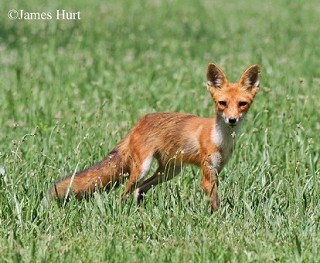Red Fox, Vulpus vulpes

This shy and wary canine, which is rarely seen during the day, is found state-wide in Tennessee.
Description: A small, doglike mammal with an elongated muzzle, moderately long legs, and a long, bushy tail with a white tip.
Ears are erect and triangular shaped. The pupil is vertically elliptical.
The long, thick, soft fur is a light orange-red with black on the back of the ear, lower legs, and feet.
Cheeks, throat, and belly are white.
Several color variations include black, silver, cross, and intermediate phases, but all have a white-tipped tail.
Length: 36 - 46 inches
Tail: 11.5 - 16 inches
Ears: 3.4 - 3.5 inches
Weight: 8 - 15 pounds
Similar Species:
- Gray Fox is slightly smaller, has a grayish fur coat, and has a black-tipped tail.
- Coyote is larger in size, has a shorter tail, and has round pupils.
Habitat: Red Foxes use a variety of habitats, but usually prefer the edges of forests and fields. They use urban areas quite frequently.
Diet: Omnivorous, but primarily eats rabbits and small rodents. They will also eat fruit, berries, insects, birds, and reptiles.
Breeding information: The breeding season is preceded by an increase in barking. Mating usually occurs in January and February. Females will use an old Woodchuck burrow, a rock cavity, or a hollow log for their den. Gestation lasts between 49-56 days, so 1-10 (usually 4-6) young are born in March or April. The dark grayish-brown pups are cared for by both parents until they are weaned around 8-10 weeks.
Status in Tennessee: Red Fox can be common in all parts of Tennessee.
Fun Facts:
- Food that is not eaten is cached under dirt, grass, or leaves for a later meal.
- Red Foxes frequently have more than one den and will transfer some of the kits there when they are 5-6 weeks old. The dens, which can be over a mile apart, are maintained by both adults.
Best places to see in Tennessee: Edges of woods and fields.